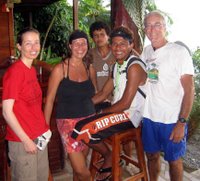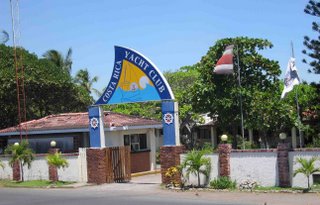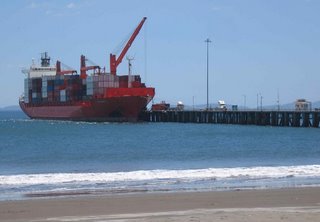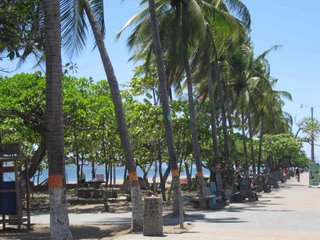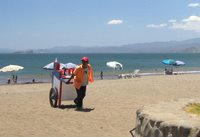Saturday, September 22, 2012
Monday, January 01, 2007
A New Year
It's a new year and it's well past time to give some attention to my much neglected Blog. Since Horizons' short excursion to western Panama at the end of May last year, and the return to Puntarenas in mid June, I've spent a few summer months in Vancouver, three weeks in England and three weeks in Belgium.
I returned to Horizons, in the boat yard at the Costa Rica Yacht Club, at the beginning of November, 2006, and have been working on a lot of much needed regular maintenance since then. So I've had little time or energy left for starting on updates to this Blog. The Blogger organisation has also updated the master Blog site over the past few months, so I've just transferred over to the new regime. There are a number of upgrades which should make the site more functional.
I will soon start to put together some new content to post here. In the meantime, may 2007 bring to you everything you wish for.
Thursday, May 25, 2006
Golfito, Golfo Dulce, Costa Rica
 I'm beginning to get my breath back a bit after the movements of the past few weeks. It's very calm and peaceful here in Golfito. There is a small village which used to be a thriving banana exportation port until the business closed down some years ago. The harbour is in a totally enclosed bay with a relatively narrow channel leading from the larger Golfo Dulce. So the anchorage is very flat and calm. It's a very welcome change after some of the rather rolly anchorages we stopped in on the way down the coast.
I'm beginning to get my breath back a bit after the movements of the past few weeks. It's very calm and peaceful here in Golfito. There is a small village which used to be a thriving banana exportation port until the business closed down some years ago. The harbour is in a totally enclosed bay with a relatively narrow channel leading from the larger Golfo Dulce. So the anchorage is very flat and calm. It's a very welcome change after some of the rather rolly anchorages we stopped in on the way down the coast.The boat is in need of a good hull cleaning after all the dirt which accumulated during my months in the estuary in Puntarenas. My old friend from Vancouver, John, was visiting me for two weeks of, for him, the unknown on board a cruising boat. This was a first time experience for John. He’d never been on a cruising/sailing boat while underway before, and certainly not overnight.
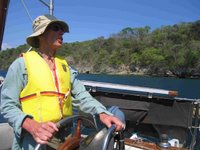
When we first pulled out of the Yacht Club, the engine was blowing huge clouds of blue smoke out of the exhaust - the result of months of running the engine at low revs without load in order to charge the batteries. The engine needed a good run under load at high revs to clean and blow out all the built up accumulated carbon and other crap. But as we motored across from Puntarenas to the nearby Isla San Lucas, the temperature gauge needle started climbing close to the overheat red zone. So I had to baby it until we made the anchorage. The next day I checked the most accessible areas in the raw wa
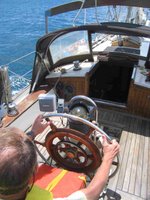 ter cooling system and removed some debris from the strainer. But our next run out, to Bahia Ballena on the Nicoya Peninsula, demonstrated that the problem had not been solved, as the engine was getting hotter than it should again. So that had to be the first project in the new anchorage.
ter cooling system and removed some debris from the strainer. But our next run out, to Bahia Ballena on the Nicoya Peninsula, demonstrated that the problem had not been solved, as the engine was getting hotter than it should again. So that had to be the first project in the new anchorage.I drained both cooling systems (fresh and raw water) the next day and removed the heat exchan
 ger. It was no surprise to find that it was clogged with a lot of organic debris which obviously got past the strainer system. I was surprised that the heat exchanger did as good a job as it did, given the amount of stuff that was obstructing the tubes. I had to clean out both ends of the heat exchanger as well as ream out a number of the tubes. As always, the biggest problem is getting the thing out of its installation location and then getting it back in place, due to the difficult access. However, this operation solved the high engine temperature problem.
ger. It was no surprise to find that it was clogged with a lot of organic debris which obviously got past the strainer system. I was surprised that the heat exchanger did as good a job as it did, given the amount of stuff that was obstructing the tubes. I had to clean out both ends of the heat exchanger as well as ream out a number of the tubes. As always, the biggest problem is getting the thing out of its installation location and then getting it back in place, due to the difficult access. However, this operation solved the high engine temperature problem.We were the only cruising boat at anchor in Bahia Ballena, and this turned out to be the case in most of the other places we stopped at. The cruising season is definitely over. John went for swims when he could,
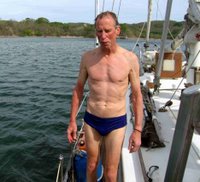 and even swam to shore from the boat in Ballena, which was a good distance. As you can see in the accompanying photo, he's doing his impression of the Duke of Kent. We also rowed to shore and took a bus to nearby Montezuma. We had a long wait for the bus, and the trip was also slow. So we didn't have very much time to explore the place. But it seemed like an interesting little village with a nice beach and lots of tourist facilities for its size. We only had time for a little walk around after having a late lunch at a beachside restaurant, and then it was time to catch the last bus at 4:00 pm. It rained for most of the way back to Tambor, in Bahia Ballena, but fortunately it eased off a bit for when we had to row back to the boat. It was a long damp row!
and even swam to shore from the boat in Ballena, which was a good distance. As you can see in the accompanying photo, he's doing his impression of the Duke of Kent. We also rowed to shore and took a bus to nearby Montezuma. We had a long wait for the bus, and the trip was also slow. So we didn't have very much time to explore the place. But it seemed like an interesting little village with a nice beach and lots of tourist facilities for its size. We only had time for a little walk around after having a late lunch at a beachside restaurant, and then it was time to catch the last bus at 4:00 pm. It rained for most of the way back to Tambor, in Bahia Ballena, but fortunately it eased off a bit for when we had to row back to the boat. It was a long damp row! 
My faltering 'fridge was going downhill fast and was barely doing its job. Eventually, it gave up the ghost. It may have leaked all its freon. I'll try to check it out with my gauges before I leave Golfito. I may be able to get it going again with some new freon, at least for a while. But in the interim, I'm having to use my backup 110 volt compressor system through my inverter. When I'm underway, I switch on the inverter and then plug in the backup fridge to the 110 volt electrical outlet and it freezes the cold plate (eventually!). The cold plate then cools the interior of the 'fridge, but I don't have
 a freezer with this system. At anchor, I've been running it on the inverter for about 1.5 hours both morning and night to try to keep it cold. But there's not been much sun, so the solar panels are not putting much back into the batteries.
a freezer with this system. At anchor, I've been running it on the inverter for about 1.5 hours both morning and night to try to keep it cold. But there's not been much sun, so the solar panels are not putting much back into the batteries.
We were trying to plan out our movements down the coast to enable John to easily return to San José when it came ti
 me for him to catch his flight back to Vancouver. But it seemed that the further we went down the coast, the more remote were the anchorages and the more difficult and time consuming it was going to be for him to travel back to San José. We thought at one point that we might have to hurry on so that we could get to Golfito from where there was at least a direct bus, even though it would be an 8 hour long bus ride. So we pressed on to Bahia Herradura, on the mainland side of the Gulf of Nicoya.
me for him to catch his flight back to Vancouver. But it seemed that the further we went down the coast, the more remote were the anchorages and the more difficult and time consuming it was going to be for him to travel back to San José. We thought at one point that we might have to hurry on so that we could get to Golfito from where there was at least a direct bus, even though it would be an 8 hour long bus ride. So we pressed on to Bahia Herradura, on the mainland side of the Gulf of Nicoya.  Again we were unable to sail. There were head winds and we had to motor into short choppy seas. So it was relatively slow going. We still had a good supply of fruit, and John was making fruit salads for breakfast.
Again we were unable to sail. There were head winds and we had to motor into short choppy seas. So it was relatively slow going. We still had a good supply of fruit, and John was making fruit salads for breakfast.We only stayed overnight in Herradura and continued on the next day to Quepos. More motoring, but at least the seas were calmer and it was a smoother and faster trip. We again simply overnighted in Quepos. The weather wasn't all that
 good, either. We had periods of rain at various times, sometimes quite heavy. The swell from offshore was pretty much ever-present, so it was a bit rolly both in the anchorages as well as underway.
good, either. We had periods of rain at various times, sometimes quite heavy. The swell from offshore was pretty much ever-present, so it was a bit rolly both in the anchorages as well as underway.Punta Uvita was the next stop down the coast from Quepos. As usual, I timed the run there to get us in
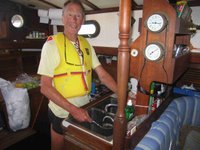 to the anchorage in the later part of the afternoon. In spite of the regular swell, the autopilot had been able to handle all the steering without any problems. John took to the cruising/motoring quite comfortably and had no real problems adapting to the motion of the boat. He did a number of hours of steering the boat early on, to get the hang of it. It was also nice to have someone else prepare many of the meals, for a change. And a fine job he did, althoug
to the anchorage in the later part of the afternoon. In spite of the regular swell, the autopilot had been able to handle all the steering without any problems. John took to the cruising/motoring quite comfortably and had no real problems adapting to the motion of the boat. He did a number of hours of steering the boat early on, to get the hang of it. It was also nice to have someone else prepare many of the meals, for a change. And a fine job he did, althoug h he was not so keen on the title of “galley slave”. The weather started closing in on us as we approached Punta Uvita, and as we made the wide sweep around the reef and into the bay, it became increasingly apparent that this anchorage was not going to provide us with any protection from the wind and sea. As we approached the indicated anchoring area, the wind picked up, it started to rain heavily, and the swell was just rolling in to the bay creating a lee shore for both wind and sea. The anchorage was clearly untenable. Although it was just after 1600 hrs, we had no choice but to turn around and continue on to Bahia Drake.
h he was not so keen on the title of “galley slave”. The weather started closing in on us as we approached Punta Uvita, and as we made the wide sweep around the reef and into the bay, it became increasingly apparent that this anchorage was not going to provide us with any protection from the wind and sea. As we approached the indicated anchoring area, the wind picked up, it started to rain heavily, and the swell was just rolling in to the bay creating a lee shore for both wind and sea. The anchorage was clearly untenable. Although it was just after 1600 hrs, we had no choice but to turn around and continue on to Bahia Drake.
I don't like arriving at a new anchorage in the dark, but we had no choice. With the reefs and rocks around the entrance to the anchorage at Punta Uvita, I would not have been happy about going into th at anchorage at night. But the anchorage at Bahia Drake was wide and open and had no problematic dangers or obstructions. So I put the waypoint into the GPS and we headed directly for it. Being underway in the dark did not seem to bother John - must have had confidence in his captain! However, I discovered that the forward bow navigation lights were not working. I'd last checked them just before leaving Puesta del Sol, when they were fine. The terminals in the anchor locker were now corroded. So I had to use the masthe
at anchorage at night. But the anchorage at Bahia Drake was wide and open and had no problematic dangers or obstructions. So I put the waypoint into the GPS and we headed directly for it. Being underway in the dark did not seem to bother John - must have had confidence in his captain! However, I discovered that the forward bow navigation lights were not working. I'd last checked them just before leaving Puesta del Sol, when they were fine. The terminals in the anchor locker were now corroded. So I had to use the masthe ad navigation lights, which I normally use only when I'm under sail. I later easily repaired the bow navigation lights after John had left the boat.
ad navigation lights, which I normally use only when I'm under sail. I later easily repaired the bow navigation lights after John had left the boat.
We entered Bahia Drake around 2200 hrs, after reaching our waypoint. Visibility was good in spite of the dark, and the radar confirmed the layout of the bay. Other than manoeuvring around several small power boats on moorings, anchoring was relatively straight forward. Bahia Drake was one place that John had been recommended by a friend in Vancouver, so he was keen to spend a little time there. As it happened, things worked out quite well in terms of doing a bit of sight seeing and prov iding him a means to easily get back to San José to pick up his return flight to Vancouver. We went to shore the next day. Unfortunately, a downpou
iding him a means to easily get back to San José to pick up his return flight to Vancouver. We went to shore the next day. Unfortunately, a downpou r started just before we got to the beach and we both got drenched. And it was hard work, even with two of us, dragging the dinghy with it's motor up the beach to where we could lock it to a post.
r started just before we got to the beach and we both got drenched. And it was hard work, even with two of us, dragging the dinghy with it's motor up the beach to where we could lock it to a post.
We found a nearby beachside lodge, where we had a beer, cleaned up and dried out a bit. The good news for John was that Marisa, day manager of this lodge, was able to book a domestic flight for him from Bahia Drake to San José for the day before his flight to Canada. This would get him there in less than an hour, provided that it didn't rain and the domestic small plane flight was able to actually take off. They apparently don't fly if the visibility is blotted out by cloud.
A highlight of this first shore visit to Bahia Drake was a filet mignon lunch at a restaurant up a hill along a dirt road behind and above the waterfront. It was delicious, particularly as it had been a while since I'd last had a good steak. The lowlight of that first visit was the fact that I wasted some time in the so-called Internet cafe trying to get a connection. I eventually had to give up on the attempt. It was the same when I tried again the next day. We found a grocery store which enabled us to replenish our d windling stock of beer and soft drinks. This was to the good. Not to the good was having my bagged running shoes disappear somewhere between the beach and the boat. Very irritating, as these running shoes were quite comfortable. My other "good" pair hurt my feet.
windling stock of beer and soft drinks. This was to the good. Not to the good was having my bagged running shoes disappear somewhere between the beach and the boat. Very irritating, as these running shoes were quite comfortable. My other "good" pair hurt my feet.
The next day was sunnier. The water was quite calm, so I took the opportunity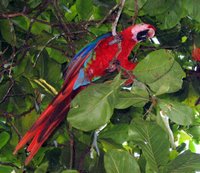 to install a new collar zinc on the propeller shaft. The old worn down one came off just before John arrived when I was cleaning the propeller in Puntarenas. On this visit to shore, we went for a hike along a rugged trail above the rocky shoreline and beach for some way. It was very hot and humid, but the scenery was beautiful. The tropical rain forest skirts this entire coast, and the trail initially took us past several waterside lodges which were now, in the low season, pretty quiet. We saw some very colourful Scarlet Macaws high up in the trees, which I initially m
to install a new collar zinc on the propeller shaft. The old worn down one came off just before John arrived when I was cleaning the propeller in Puntarenas. On this visit to shore, we went for a hike along a rugged trail above the rocky shoreline and beach for some way. It was very hot and humid, but the scenery was beautiful. The tropical rain forest skirts this entire coast, and the trail initially took us past several waterside lodges which were now, in the low season, pretty quiet. We saw some very colourful Scarlet Macaws high up in the trees, which I initially m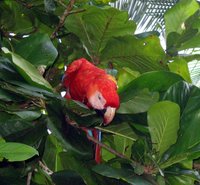 isidentified as parrots. They were quite large, and noisy. It was a tiring and sweaty hike, and the beer was very welcome on our return to Jinetes, the beachside lodge we were at earlier.
isidentified as parrots. They were quite large, and noisy. It was a tiring and sweaty hike, and the beer was very welcome on our return to Jinetes, the beachside lodge we were at earlier.
John wanted to return to the restaurant up the hill for dinner, so this time I had a sirloin steak. I normally like to be back on the boat before dark, especially when at anchor. On this occasion, I was concerned about my cockpit anchor light coming on as the light sensor was malfunctioning. However, when we returned to the dinghy on the beach in the dark, I saw a light which appeared to be my anchor light in the distance - although the water depth was only 22 feet, the boat was quite a distance from the beach. We got the dinghy through the surf and were headed for the boat when I noticed a lot of water in the dinghy. I'd left the plug out after draining it on the beach earlier in the day and hadn't noticed it in the dark. I put the plug back in place. John bailed. S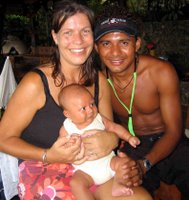 o John was getting a first hand look at how Murphy constantly causes mischief (sometimes with a little help from me).
o John was getting a first hand look at how Murphy constantly causes mischief (sometimes with a little help from me).
The following day, we were picked up by a launch that John had organised and we were taken to a popular beach and snorkelling area a short distance along the coast. The launch operator, Wilberto, was a local who had "connected" with a Dutch woman, M artine, and they now had a one month old baby boy. They were planning on travelling to Holland for about a year or so within the next few weeks. From San Josecito Beach, we walked along the trail above the beach for some distance until we got to Rio Claro, a small river which emerges at the beach from the jungle. There, we took a small boat paddled by a guide and s
artine, and they now had a one month old baby boy. They were planning on travelling to Holland for about a year or so within the next few weeks. From San Josecito Beach, we walked along the trail above the beach for some distance until we got to Rio Claro, a small river which emerges at the beach from the jungle. There, we took a small boat paddled by a guide and s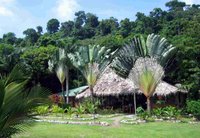 lowly made our way up the little river. At one spot, we had to get out of the boat while the guide hauled it through a narrow gully or rapid. We made our way as far as a bigger set of rapids, where we left the boat and hiked along the steep jungly sides of the river for a little way. It was around the middle of the day, so we didn't see much wildlife, other than a couple of Boat-Billed Herons - peculiar looking birds with big red eyes and wide flat beaks.
lowly made our way up the little river. At one spot, we had to get out of the boat while the guide hauled it through a narrow gully or rapid. We made our way as far as a bigger set of rapids, where we left the boat and hiked along the steep jungly sides of the river for a little way. It was around the middle of the day, so we didn't see much wildlife, other than a couple of Boat-Billed Herons - peculiar looking birds with big red eyes and wide flat beaks.
It was hot and humid, although we were in the shade of the trees for much of the time. John was learning about the lethargy that this climate produces, although he said that it was similar to what he'd experienced during his recent trip to Cambodia. Back at San Josecito Beach, John went for a swim, taking the opportunity to use his snorkel and mask at least once to justify its place in his luggage. We had to be back at Jinetes lodge by about 1430 hrs for John to confirm his flight the next day to San José.
This was John's last day on the boat, and it was also the last nice day we've had. Since then, it's been rainy and overcast, with only occasional sunny spells. His last night on the boat was, for me, quite uncomfortable, as there was a heavy swell which was causing the low slung dinghy on its davits to be repeatedly hit by the waves, causing a lot of noise, vibration and stress on the gear. I had to lower it to the water and tie it alongside at about 0130 hrs. The swell had also caused one of my fenders to come loose and detach from the lifeline, disappearing into the night. Then the onshore wind increased and a downpour with thunder and lightning started. So I kept watch until the wind eased. 
It was still raining lightly at 0630 hrs, and I was a bit concerned that John's plane might not get away. But it brightened up later in the morning around the time I took John to shore to catch his taxi to the local airport. The bad weather held off long enough for John's plane to take off late in the morning, as I saw the plane heading inland. Later in the day, t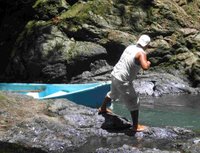 he weather closed in again, so he was lucky to get off the ground when he did.
he weather closed in again, so he was lucky to get off the ground when he did.
I'd planned to leave for Golfito the following morning after John's departure. But the weather was heavy and grey during the night, and a tropical downpour started at about 0600 hrs, just when I was planning to leave. So I decided to delay my departure for 24 hours to wait for better weather. The next morning I was awakened by heavy rain at about 0330 hrs, just when I was planning on getting up in order to leave at 0400 hrs. But the rain e ased and I got under way shortly after 0400 hrs. As had been the case since leaving Puntarenas, there was no wind. So it was more motoring through the heavy swell. It was over 65 miles to Golfito, so it was going to be a long day. The early start was necessary to be
ased and I got under way shortly after 0400 hrs. As had been the case since leaving Puntarenas, there was no wind. So it was more motoring through the heavy swell. It was over 65 miles to Golfito, so it was going to be a long day. The early start was necessary to be sure of getting there before dark.
sure of getting there before dark.
As skipper and author of this Blog, I’m now going to issue an official command, punishable on violation by a keel hauling, that any boaters or other cruisers reading this must skip over the next four paragraphs following this one, leaving them unread. And no backtracking!
The most “exciting” moment of the journey was having the engine stop running without warning when I was over two thirds of the way there. I was just under 3 miles from the rather rocky coastline an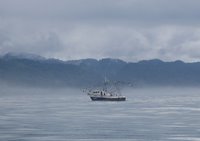 d it was particularly worrying in that there was no wind for sail power and I was concerned that I might be washed onto the shore. I already had the Main sail up as a steadying sail in the swell. I unfurled the genoa, but all it did was flap about. Fortunately, I was able to quickly discover the problem which, for once, was not caused by Murphy. I'd run out of fuel!
d it was particularly worrying in that there was no wind for sail power and I was concerned that I might be washed onto the shore. I already had the Main sail up as a steadying sail in the swell. I unfurled the genoa, but all it did was flap about. Fortunately, I was able to quickly discover the problem which, for once, was not caused by Murphy. I'd run out of fuel!
Circles within circles. When I'd refuelled in Puntarenas, I was concerned about putting too much diesel into the tank because I wanted the boat to be as light as possible for when it is later hauled out of the water on m y return to Puntarenas. The reason for this is that the Travelift at the Yacht Club is at its upper weight limit for hauling my boat. So I kept the last 20 gallons of fuel in my jerry jugs on deck, to be used as needed. Since leaving Puntarenas, to help blow out the carbon and crud which has built up in the engine over the previous months, I've been running the engine at around 2600 - 2800 rpm rather than my usual 2200 - 2400 rpm. This uses a disproportionate amount of additional fuel for the speed gained. I'd also been using the engine exclusively, without any opportunity for sailing. But I ought to have been keeping track of my fuel consumption, as I usually do. At the very least, I should have simply put more of my jerry jug fuel into the tank along the way. It emphasises the importance of sticking to one’s regular routines.
y return to Puntarenas. The reason for this is that the Travelift at the Yacht Club is at its upper weight limit for hauling my boat. So I kept the last 20 gallons of fuel in my jerry jugs on deck, to be used as needed. Since leaving Puntarenas, to help blow out the carbon and crud which has built up in the engine over the previous months, I've been running the engine at around 2600 - 2800 rpm rather than my usual 2200 - 2400 rpm. This uses a disproportionate amount of additional fuel for the speed gained. I'd also been using the engine exclusively, without any opportunity for sailing. But I ought to have been keeping track of my fuel consumption, as I usually do. At the very least, I should have simply put more of my jerry jug fuel into the tank along the way. It emphasises the importance of sticking to one’s regular routines.
When the engine stopped and after unfurling the genoa, the first thing I did was check the primary fuel filter housing. As suspected, it only had a small amount of fuel remaining in it. With a marine engine, curing this out-of-fuel problem is not a simple matter of putting more fuel into the tank and starting up the engine, as it is with a car. The fuel system must also have the air bled out of the fuel lines all the way from the fuel tank to the engine. I put 10 gallons of diesel into the tank. I restarted the siphon effect in the line from the tank to the primary filter by sucking o ut the air (diesel fuel doesn't taste very good) to get the fuel to flow. I filled the secondary filter housing with fuel. I then bled the air out of the secondary filter on the engine. But the hard part was bleeding out the air from the fuel injection pump. The engine was hot, and the bleed screw on this pump is behind hot pipes and hoses and is hard to reach at the best of times. All the while, I was keeping an eye on the boat's position relative to the shore, via the radar. I was not at my most relaxed, particularly as it was very difficult to get my spanners to the necessary places on the fuel pump. I was hot, pouring with s
ut the air (diesel fuel doesn't taste very good) to get the fuel to flow. I filled the secondary filter housing with fuel. I then bled the air out of the secondary filter on the engine. But the hard part was bleeding out the air from the fuel injection pump. The engine was hot, and the bleed screw on this pump is behind hot pipes and hoses and is hard to reach at the best of times. All the while, I was keeping an eye on the boat's position relative to the shore, via the radar. I was not at my most relaxed, particularly as it was very difficult to get my spanners to the necessary places on the fuel pump. I was hot, pouring with s weat and quite anxious.
weat and quite anxious.
However, I finally managed it and completed the bleeding process up to the injectors on the engine. And best of all, the engine then started at first attempt. It was a big relief that the boat didn't drift towards shore. It just remained a similar distance away for the hour it took me to complete the refuelling and bleeding process. Once underway and back on course, I put the remaining 10 gallons of diesel into the tank. Although I'd lost an hour, I still managed to get into the anchorage at Golfito before dark.
I'm loving this anchorage after the rolly ones up the coast. It's flat and dead calm here, so I'm enjoying the comfort. I've also caught up with fellow cruisers Candy & Gene, of "Passage". I first met them in Nicaragua, and then again in Puntarenas. They are in Banana Bay Marina, which is a somewhat expensive spot. They will be shipping their boat back to the USA from Golfito in late June (actually, to Ensenada in Mexico, just south of San Diego) by the Dockwise Transport ship. So, other than some road trips inland and possibly down to Panama City, they are hanging around here until then, after having cruised a bit of western Panama.
Yesterday was tankage day. I filled my water tank with an additional 47 gallons, and added another 47 gallons of diesel to the fuel tank. Diesel is expensive here, at US$3.05 a gallon. Today, I need to do some shopping. I'm planning on leaving here for western Panama on an overnighter early next week. It’s another trip of over 62 miles. So a morning arrival will guarantee me lots of daylight and time to get checked into the country. I'll probably hang about in a small island group for several days and then head back to Costa Rica and Puntarenas. I don't know my precise timing at the moment. 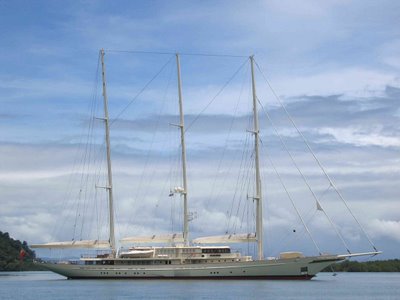
Saturday, May 20, 2006
Golfito, Costa Rica
I arrived in Golfito in southern Costa Rica a couple of days ago after a day long motor sail from Bahia Drake. I'm presently anchored close to Banana Bay Marina, in the well protected bay. It's a relief to have the boat hold steady after the heavy rolling from the swells at Bahia Drake. The rainy season seems to be now establishing itself, and it's now a bit of an effort to keep things dry in the boat.
I will post a fuller update very soon, including an account and some photos covering the visit of my old friend, John, from Vancouver. He returned home earlier in the week after two weeks of learning a bit about the mundane life of a cruiser. I now need to do some reprovisioning of the boat after being away from "civilization" since leaving Puntarenas. This includes obtaining more diesel fuel (I've used a lot more than I expected) and fresh water.
Thursday, March 30, 2006
Puntarenas Scenes
 Puntarenas is on a long narrow peninsula in the Gulf of Nicoya, Costa Rica. The estuary on its north shore (left) is shallow and boats accessing the Costa Rica Yacht Club may only enter or leave close to the rising high tide. This is quite an old photo, and does not show the "new" jetty. To the right is the beach fronting on the Gulf of Nicoya. Skirting that beach is the Paseo de Turistas.
Puntarenas is on a long narrow peninsula in the Gulf of Nicoya, Costa Rica. The estuary on its north shore (left) is shallow and boats accessing the Costa Rica Yacht Club may only enter or leave close to the rising high tide. This is quite an old photo, and does not show the "new" jetty. To the right is the beach fronting on the Gulf of Nicoya. Skirting that beach is the Paseo de Turistas. The estuary at the Yacht Club is well protected, and is calm even during strong winds.

Horizons (brown canvas on both main and staysail booms) can be seen about the third mast from the left, with the mangroves in the near background and the cloud forest mountains in the distant background.
This is the view I have from my galley porthole as I make my breakfast.
A container ship at the "new" jetty. which is also used by cruise liners.
The lifeguard has a beautiful view of the Gulf of Nicoya.
View to the south, looking down the Gulf of Nicoya
One of the beachside picnic areas.
Two views of the Paseo de Turistas.
Beach vendor.
Restored old church in the centre of Puntarenas.
Modern new church near the point on the peninsula.
One of the ferries which leaves from near the end of the estuary side of the Puntarenas peninsula, to cross the Gulf to the Nicoya Peninsula.
Some of the fish docks just upstream of the ferry dock.

